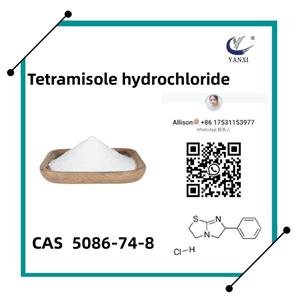hydrochloride
-
Cas 593-51-1 Methylamine Hydrochloride Methylammonium
Methylamine hydrochloride, also known as monomethylamine hydrochloride, is a white crystalline powder in appearance. It is soluble in water, ethanol, insoluble in ether, acetone and chloroform; It is hygroscopic and irritating. Methylamine hydrochloride can be used in medicine, pesticide, fuel and other organic synthesis of basic raw materials, oil fields, etc.
Email Details -
Cas 1786-81-8 Prilocaine Hydrochloride
Prilocaine hydrochloride is an aminoamide local anesthetic. Pilocaine is commonly used in dentistry. Procaine is also often combined with lidocaine as a preparation for skin anesthesia (lidocaine/procaine or EMLA) for conditions such as paresthesia.
Email Details -
3-Hydroxytyramine /4-(2-Aminoethyl)benzene-1,2-diol 62-31-7
Dopamine hydrochloride is an off-white crystal that should be stored in a cold, ventilated, dry warehouse,at the same time stable. Incompatible with strong oxidizing agents. Combustible.
Email Details -
Levamisole Hydrochloride CAS 16595-80-5
Levamisole Hydrochloride CAS 16595-80-5 is an organic molecular entity. Levamisole Hydrochloride is about twice as active as racemic and has low toxicity and side effects. Levamisole Hydrochloride / L-Tetramisole as an insect repellent, it has an insect repellent and immunomodulatory activity. It is suitable for treating animal mites, hookworms, etc.
Email Details -
Tetramisole Hydrochloride/anthelvet CAS 5086-74-8
Tetramisole CAS 5086-74-8 was originally used as an anthelminthic to treat worm infestations in both humans and animals. Most current commercial preparations are intended for veterinary use as a dewormer in cattle, pigs, and sheep. Tetramisole CAS 5086-74-8 has also recently gained prominence among aquarists as an effective treatment for Camallanus roundworm infestations in freshwater tropical fish. It is a broad-spectrum anthelminthics, used to control roundworm and hoodworm.
Email Details -
Cas 10085-81-1 Benzoctamine Hydrochloride Anesthetic
Benzocaine hydrochloride is a surface anesthetic that acts by preventing transmission of impulses along nerve fibers and at nerve endings.Benzoctamine hydrochloride is used as a local anesthetic. Long-lasting effect, small toxicity. Mainly used for skin diseases to relieve pruritus, trauma, hemorrhoids and ulcer surface pain relief.
Email Details -
Cas 51-05-8 Procaine Hydrochloride Novocaine HCL
Procaine Hydrochloride is a local anesthetic drug of the amino ester group. It is used primarily to reduce the pain of intramuscular injection of penicillin, and it is also used in dentistry. It acts mainly by being a sodium channel blocker. Today it is used therapeutically in some countries due to its sympatholytic, anti-inflammatory, perfusion enhancing, and mood enhancing effects. Procaine HCl is indicated for the production of local or regional analgesia and anesthesia by local infiltration and peripheral nerve block techniques.
Procaine hydrochloride cas 51-05-8 novocaine HCL 2-(Diethylamino)ethyl 4-Aminobenzoate HydrochlorideEmail Details -
Cas 73-78-9 Lidocaine Hydrochloride Lidothesin
Lidocaine Hydrochloride,Local Anesthetic Drugs Lidocaine, also known as xylocaine and lignocaine, is a medication used to numb tissue in a specific area and to treat ventricular tachycardia. It can also be used for nerve blocks.Lidocaine mixed with a small amount is available to allow larger doses to be used as numbing and to make it last longer. When used as an injectable it typically begins working within four minutes and lasts for half an hour to three hours. Lidocaine may also be applied directly to the skin for numbing.
Email Details -
Cas 136-47-0 Tetracaine Hydrochloride/Pantocaine
Tetracaine hydrochloride is a highly effective local anesthetic that can reversibly block nerve function. Tetracaine hcl used as a local anesthetic. Tetracaine hydrochloride can be used for topical anesthesia, and 0.05%-0.1% tetra caine hydrochloride can provide long-term and good effect of surface anesthesia. Meanwhile, tet racaine hydrochloride is still widely used in ophthalmic surface anesthesia, which has a long time for surface anesthesia and sensory resistance.
Email Details













